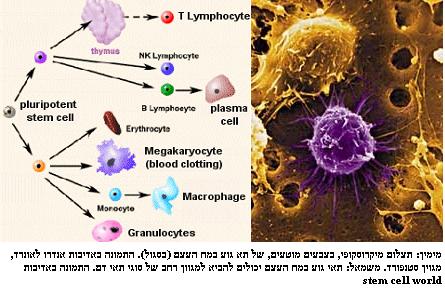Researchers at NASA's Space Radiation Laboratory are developing methods to deal with exposure to space radiation, which damages the body's ability to produce blood cells. The implications of the research - also for patients with blood diseases such as leukemia and anemia
By: Ariel Eisenhandler, Israel Astronomical Society
 In the time it takes you to read this sentence, more than 10 million red blood cells in your body will die. Don't stress; This is natural, and stem cells in your bone marrow regularly produce enough new cells to replace those that have died and are dying. But what happens if those blood-producing cells stop working? Without a fresh supply of red and white blood cells you will quickly become anemic, your immune system will collapse and without medical treatment you will die.
In the time it takes you to read this sentence, more than 10 million red blood cells in your body will die. Don't stress; This is natural, and stem cells in your bone marrow regularly produce enough new cells to replace those that have died and are dying. But what happens if those blood-producing cells stop working? Without a fresh supply of red and white blood cells you will quickly become anemic, your immune system will collapse and without medical treatment you will die.
This can be of interest and the main problem of astronauts who fly long flights beyond the Earth's orbit. It is a known fact that space radiation can damage the cells in the body of astronauts. Less well known is the specific threat to the key blood-producing cells.
Understanding the threat and developing a cure is the role of Alan Gewirtz, a doctor at the University of Pennsylvania, who works in the department of hematology (blood theory) and oncology (tumor theory and cancer treatment for minors). In his experiment, he bombards stem cells with an imitation of space radiation to test how the cells are affected. By examining the molecular damage, and testing the candidacy of drugs, "not only astronauts, but also humans on Earth who suffer from diseases and blood disorders such as leukemia (blood cancer) and aplastic anemia (lack of development) will be able to benefit from this research," says Gwirtz.
The work is done at the NASA Space Radiation Laboratory (NSRL - NASA Space Radiation Laboratory) in New York. This lab takes high-speed particles from one of Brookhaven National Laboratory's atom smashers on Long Island and channels them into a special facility for biological research. The radiation consists of protons and heavy ions moving almost at the speed of light - very similar to the cosmic radiation encountered by astronauts in deep space.
The danger: a long flight into space
The Apollo astronauts absorbed some of the cosmic radiation on their way to the moon, but they didn't suffer much from it, since these trips were short, a matter of a few days. In contrast, astronauts who will fly to Mars will stay in space for at least six months. Accumulating damage from cosmic radiation can become an important matter.
To test how cosmic radiation affects the internal blood supply of astronauts, Goertz exposes to radiation petri dishes (editor's note: flat dishes used for tests and experiments in laboratories - invented by Julius R. Petri, a German bacteriologist who lived in 1921-1825) containing samples of Blood-producing stem cells. Each sample contains approximately one million cells collected from the bloodstream of healthy donors. After the cells have been exposed to radiation, the team looks for damage. Are the DNA strands ("Memory cards to create new cells") affected? If so, then how and how severe is the damage? Are other internal cell machinery parts damaged? In what form?
Don't mistake these stem cells for controversial embryonic stem cells: Gwirtz only works with adult stem cells. Adult stem cells live in several places in every human body, such as: bone marrow, brain, skin and intestines. Unlike most cells in the body, stem cells do not have to function as a single type of cell, such as a heart or kidney cell. Instead, they have the ability to become any type of cell - a feature called "pluripotency" or "multipotency".
A constant supply of cells
Stem cells in the bone marrow, called "hematopoietic progenitor" cells, produce a continuous supply of cells that can become: platelets, lymphocytes (lymph cells), granulocytes (a type of white blood cell), erythrocytes (red blood cells) ) and others. In this way the stem cells are a source of fresh replacement cells that take the place of worn out old cells.
In addition to assessing radiation damage to hematopoietic progenitor cells, Gwirtz's group plans to test drug-like "countermeasures" that could help astronauts tolerate low-level radiation exposure. One idea is to give the cells antioxidants. Most of the DNA damage It is not from the radiation itself but from a chemical reaction with "free radicals" that were created when the radiation hit other molecules. These wandering free radicals begin to oxidize the DNA. And thus they cause him harm. Cleaning these free radicals with antioxidant substances, in the form of pills, can slow down or stop the damage.
Another approach the researchers are considering is increasing the power of the natural system in human cells that repairs DNA; In a normal state, the cells contain dozens of unique repair enzymes, which run regularly along the DNA molecules. The stringy and long ones, check for damages and repair them. "We hope to find a way to stimulate the natural repair mechanism," says Gwirtz. "It's hard to beat millions of years of evolution to choose what works, and works well."
Will these countermeasures help protect the cultured cell samples? Gwirtz says his team should have results by the end of the year. If they succeed, astronauts on their way to Mars won't have to worry about their internal new blood cell "springs" drying up.
For information on the NASA website
